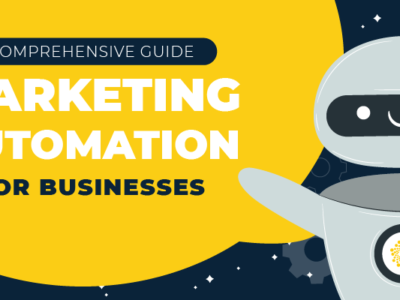Your sales reps are slogging day in and out to reach their revenue targets. Despite their tedious effort, the numbers still don’t seem to go up.
Your sales team faces multiple challenges between prospecting, nurturing, and closing a lead.
Performing repetitive and mechanical tasks is one of the most significant barriers to your team’s peak performance—with sales executives spending less than 40% of their time on primary sales activities.
So, how can you remove these mundane tasks from the picture and double down on selling? Simple—with sales automation.
Sales automation optimizes your sales pipeline and empowers your reps to focus more on productive activities. Read along to learn more about the impact sales automation can make for your business and five best practices to incorporate automation in your workflows.
Why sales automation matters
Automation is more than a buzzword in the world of sales. Sales automation is changing the game for sales teams by creating a more efficient and effective framework to close deals.
A standard sales process includes several steps, which are repetitive and require too much manual effort. This is where automation offers a unique advantage. Automating these tasks can free up your reps’ time for more essential duties.
Introducing automation can ultimately maximize your ROI and increase your bottom line—with 61% of businesses that used sales automation claiming higher revenues than expected.
The best part: automation works equally well for selling physical and digital products. Let’s take a closer look at some of the most crucial benefits of sales automation:
- Low expenses, high revenue: Automation reduces the dependence on manual effort and minimizes the need to hire more people. So, your overall expenditure automatically dips. On top of reducing your expenses, automation can also scale your revenue—with brands seeing a 225% increase in sales opportunities by automating lead nurturing.
- Streamlined pipeline management: Sales pipeline management is no cakewalk. From lead generation to follow-ups, you can automate several processes for lead nurturing to put a majority of your client acquisition strategy on auto-pilot.
- Data-informed decision-making: Automation brings with it a lot of data for decision-making. You can leverage business intelligence to make the most informed decisions for your company. Plus, data analytics can accelerate your decision-making process by 5 times.
- Personalized communication: Sales automation perks are not limited to generating and converting leads. The technology can work wonders for your customer retention strategy too. Automation allows you to personalize all communication—whether it’s an email sequence or a push notification on the app—and build strong relationships.
- Efficient and accurate reporting: Sales is a numbers game, and automation is the power tool to analyze these numbers. It can save you hours spent compiling reports through data analytics. Incorporating automation into a tool like CRM can automatically create precise and meaningful reports for your team.
The bottom line: automation can equip you with the right infrastructure to unlock more revenue by optimizing your sales funnel. You have the flexibility of choosing the scope of automation you want to implement and evaluate the ROI before diving deeper into it.
Also Read: Mastering Lead Generation: Expert Strategies
5 best practices to adopt sales automation
McKinsey’s research states that you can automate over 30% of your sales activities. Let’s find out where these opportunities lie and how you can tap into these areas to drive up your adoption of sales automation.
1. Automate prospecting and lead qualification
You’d probably generate thousands of leads to approach. A long list of leads doesn’t guarantee more sales. You have to filter your list to find the best opportunities and increase your ROI. This method of processing and prioritizing the most relevant leads is called lead qualification.
That being said, lead qualification is a lengthy and time-consuming process. You have to create a detailed workflow with different steps to establish touchpoints with your leads, capture their data for lead scoring, and qualify them.
40% of sales executives directly correlate the lack of an effective strategy to their poor lead generation performance.
Here’s what you can do to automate your prospecting and lead qualification processes:
- Dynamic forms: When collecting leads from a landing page, use smart forms to segment a lead into different categories automatically. A smart form will display only the most relevant fields to a prospect. For instance, if they’re a B2B company, they can choose “B2B” in business type, and your dynamic form will send a specific set of questions.
- Chatbot conversations: Chatbot is another key avenue to automate your lead generation and qualification effort. Create a well-charted conversation sequence to ask questions and collect all the data from a prospect via chat. Your CRM will gather all this information for your sales team. Here’s an example of how it’s done:
- Lead scoring: This is the technique of analyzing and scoring a prospect’s information to assess whether they’re a good fit for you or not. Automating your lead scoring process accelerates your qualification workflow and shortens the sales cycle—putting you in the front seat for closing more deals faster.
- Qualification workflows: How do you assess if your website visitors are qualified leads for your sales efforts? You can do this by creating automated workflows that qualify your visitors based on specific actions, like downloading an eBook or signing up for a webinar. These workflows will trigger your communication channels to initiate lead nurturing.
The first step of your sales cycle is the most tedious one. Spending more time in finding and qualifying leads manually can slow down your entire process and derail your efforts.
For example, tools like sales navigator leads scraper can streamline this process by efficiently extracting potential leads from LinkedIn Sales Navigator, helping your sales team build a robust pipeline quickly and effectively.
2. Map and personalize your customer journey
Automation can supplement your effort to deliver a flawless customer experience before and after making the sale. Once you’ve mapped your buyer’s journey down the acquisition funnel, you can create automated systems to eliminate any inefficiencies.
This is a win-win for both your sales reps and prospects. While your reps can save a lot of time sending emails and following up, your prospects get a quality experience. Here’s how:
- Targeted communication: Automated workflows can deliver content that meets a lead’s requirements. How? By reviewing details like lead score and buyer segmentation, this communication sequence will push the lead further into your funnel and simplify your reps’ role.
- Email sequences: Mapping your customer journey also helps personalize your communication with prospects via automation. You can create a collection of emails, template messages, and canned responses to save your team the time of creating everything from scratch. These dynamic emails deliver precise messaging to nudge your customers towards a purchase.
- Customer support: Automation can also enhance your customer satisfaction levels through prompt and precise customer service. From live chat to self-service, automation takes many forms for offering personalized customer support.
Groove’s knowledge base, for example, serves as a self-service automation avenue to help customers.
Sales automation can transform your customer journey and simplify the buying process with greater ease of communication and support.
3. Targeted reporting with accurate data
The shorter your sales cycle, the higher conversions you can bring in. Sales automation reduces your cycle’s length to increase your win rate and revenue. Data and business intelligence are the most crucial contributors in the process.
Using a CRM tool can put your reporting process on autopilot and present a crystal clear view of your sales performance. It can offer insights into:
- Multiple sales metrics to assess your team’s performance
- Success or failure of different campaigns and individual reps
- Growth opportunities that lie ahead for achieving revenue targets
- Smart goal-setting based on your sales performance and progress
Data and reports are vital for your sales success. By creating an automated system for reporting, you can shift your focus to strategizing and execution.
4. Accelerate outreach on social media
Social selling can do wonders for a salesperson—bringing 51% or more revenue than their designated quota. But social media outreach is equally tiring and time-consuming.
The process of finding, qualifying, pitching, and converting a prospect on social media requires consistent effort and tireless follow-ups. Automation can turn things around for social outreach by cutting down the manual effort involved and generate new appointments on autopilot.
Here are some best practices you can follow for automating your outreach:
- LinkedIn: LinkedIn is a goldmine for B2B sales. You can easily integrate multiple sales automation tools to find the best leads, send cold messages, and supercharge your sales campaigns on the platform. Check out these few tools:
- Expandi: connect with targeted profiles and automate your prospecting process
- LinkedIn Sales Navigator: advanced lead search and filtering capabilities
- Twitter: Start a conversation and build a rapport with your potential customers on Twitter before pitching them your product/service. Twitter automation tools help you find leads, send messages, and match LinkedIn profiles with Twitter accounts effortlessly.
- Retargeting ads: Besides your personalized outreach campaigns, you can also automate your ads. Automation mainly helps run retargeting ads to nurture the prospects you’ve collected from LinkedIn and Twitter.
Automating your outreach on social media can open up a huge gateway for client acquisition—all while saving your reps the struggle of constant follow-ups and prospecting.
5. Automate and streamline ad campaigns
Ads act as a link between sales and marketing. Automated systems can make this link stronger and directly impact your revenue.
While ads disrupt your users’ viewing experience, you can personalize your ads to hit the right chord. This is where AI-powered automation can boost your potential for advertising.
AI analyzes tons of data points available on digital platforms to give you an accurate estimate of your target audience, customer segmentation, performance patterns, and KPIs. With this information, you’re all set to scale your campaigns at any point.
Here are some key areas you can tap into using automation for advertising:
- Customer data: AI automation examines your customer data to create accurate segments and patterns. It can also help determine the impact of each ad campaign based on these data insights.
- Campaign recommendations: AI can make constructive suggestions for creating an ad campaign based on its analysis of customer data.
- Scheduling: AI undoubtedly plays a vital role in scheduling ads for the best times based on people’s rate of view, open, and click.
Automation can multiply your leads and sales with precise, AI-powered ad campaigns. Doing so nurtures better coordination between your marketing and sales teams. By integrating LinkedIn advanced search into your automation strategy, you can efficiently identify and connect with potential leads at scale.
Conclusion
Sales automation can create an exponential impact for your business—depending on how you leverage it. It’s one of the easiest ways to make your team future-ready and better-equipped for sales success.
Implementing sales automation can bring multifaceted results—from lead generation to customer satisfaction.
So, use this guide to create your sales automation strategy and skyrocket your business growth. Make a solid game plan to improve your sales productivity and deliver enhanced customer experiences.





